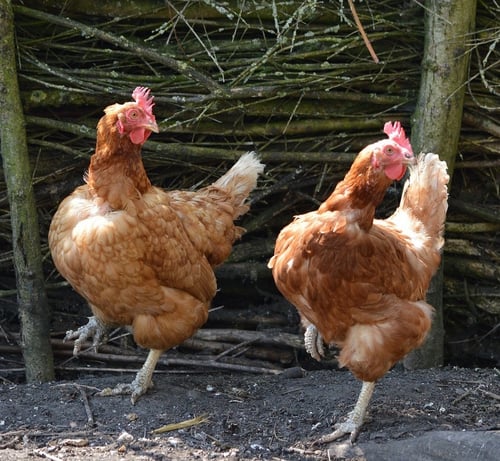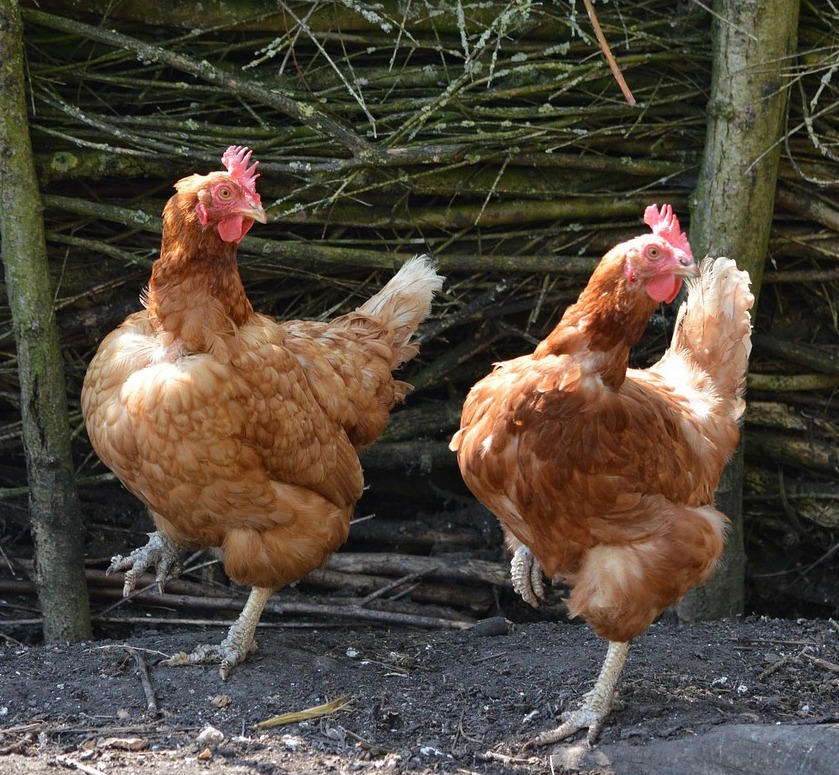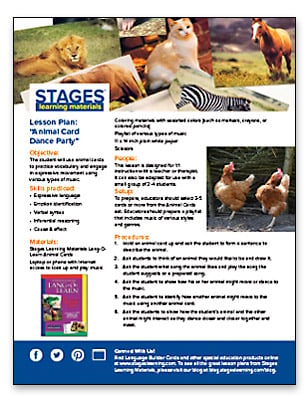Animal Cards Dance Party
Lesson Overview
Students will make an animal that they would most like to be or admire in some way. Students will then choose a song that their animal likes and move their animal to the rhythm of the music. Students will then listen to various types of music and choose other animals to move, following the rhythm of the song. Students will then see how different animals might interact with each other. This is an early childhood activity that can be adapted to special needs students by breaking down the activities and reinforcing the steps separately. Students can build skills that they can use to interact with their peers.
Objectives/Goals
-
Animal identification and vocabulary
-
Perspective-taking
-
Fine and gross motor development
-
Conceptualization skills
-
Dealing with potential body image issues
-
Expressive movement
Materials
- Stages Learning Materials Lang-O-Learn Animal Cards
- Laptop or phone with Internet access to look up and play music
- Coloring materials with assorted colors (such as markers, crayons, or colored pencils)
- Playlist of various types of music
- 11 x 14 inch plain white paper
- Scissors
People
This lesson is designed for 1:1 instruction with a teacher or therapist but can be adapted for a small group.
Setup
To prepare, educators should select 3-5 cards or more from the Animal Cards set, depending on the vocabulary development of the student. Educators should prepare a playlist that includes music of various styles and genres ranging from slow and soft to loud and rhythmic. It is also important to make sure that devices are able to play the music and have Internet access to look up music.

Procedures
- Hold up an animal card so the image is facing the student.
- As the student looks at the cards, ask the student to form a sentence to describe the animal using adjectives (colors, personality, appearance, emotion).
- Allow students to see or listen to a sentence frame (“The______is______”) to help with their oral response, if necessary. Ask guiding questions such as “What color is the animal?” or “Is the animal big or small?” to elicit responses if necessary.
- Ask the student to think of an animal they would like to be and draw it using the materials provided.
- Once the student is finished, ask if she or he would like to cut out the image. If the student would like to, allow her or him to cut out the image using scissors.
- Ask the student what song the animal likes.
- If the student has a song in mind, look up the song on a device and play it.
- Using another animal card, model how another animal might move to the rhythm of the music. For example, a rabbit might hop to the music, so the card can be moved in hopping motions to the rhythm of the music.
- Ask the student to show you how his or her animal might move or dance to the music using his or her animal card.
- Play a song with a different tempo and style.
- Ask the student how his or her animal might move to this new music by showing you with their drawing.
- Ask the student to identify how another animal might move to the music using another animal card.
- Ask the student to show you how the animals might dance closer to each other and interact with each other when they meet.
- Depending on the student, you can move one animal card while the student moves the drawing, bringing the two animals closer together. You can also give the student control of both animals.
- Continue playing new songs and engaging different animals. If done in a group, students can interact with each others’ animals and choose a new person/animal to interact with as each new song plays.
- When the activity is finished, ask the students to identify which animals they danced with today and which movements they enjoyed.
Additional Suggestions for Support
-
Provide choices – In each step of the process, offer choices and alternatives for how students might want to engage. For example, since students might not want to have the animals move toward each other, you can suggest that the animals can move away from each other. Students should also have the choice of whether they want to control both animals or only their own.
Pre-teach vocabulary - Before your activity, don’t forget to pre-teach essential vocabulary to ensure students are equipped with the language required for success. Show students a visual image that represents the word and ask them to say the word after you. This support is especially important for language learners.
Modeling motion – Model moving to the music in different ways to help students gain a sense of musical expression and rhythm. Encourage students to mirror your movements in their responses if they need additional support.

Grace Chen
Grace Chen is currently pursuing an Ed.M. in Arts in Education at Harvard Graduate School of Education. She has been a teaching artist, curriculum developer, and research assistant focusing on innovative evaluations in out-of-school time programs. She hopes to develop resonant and empowering art programs by partnering with youth in educational research and practice.






